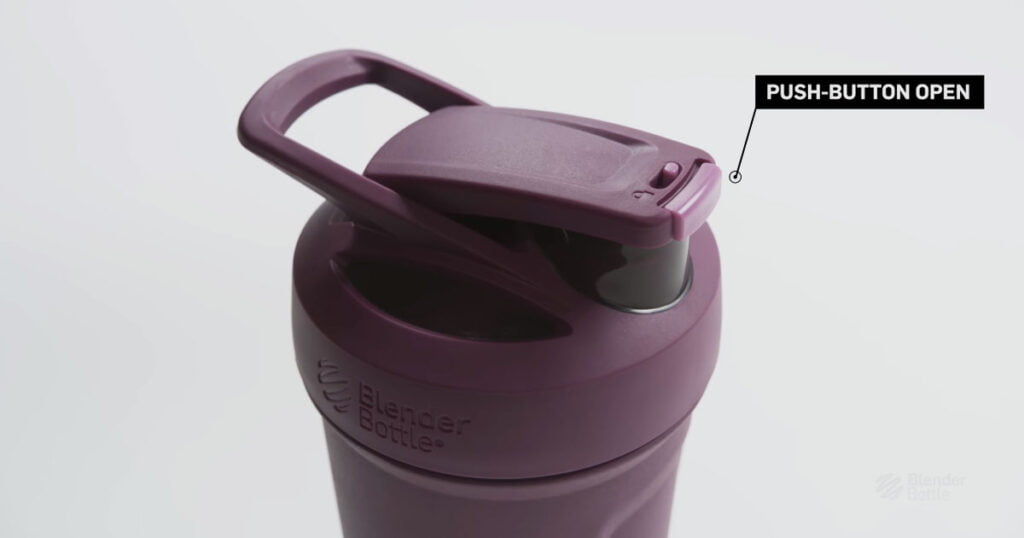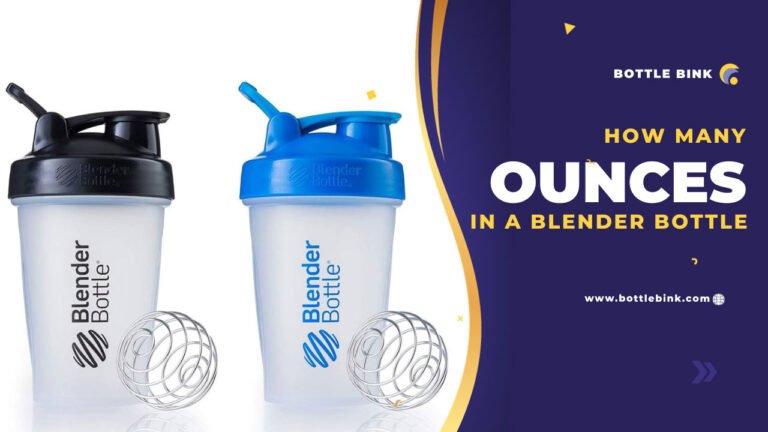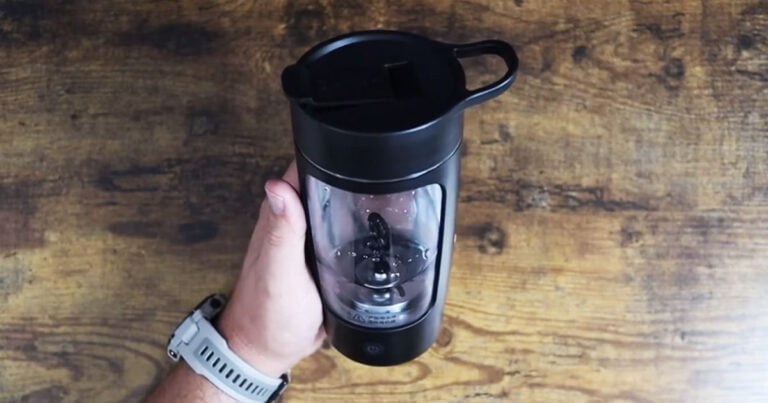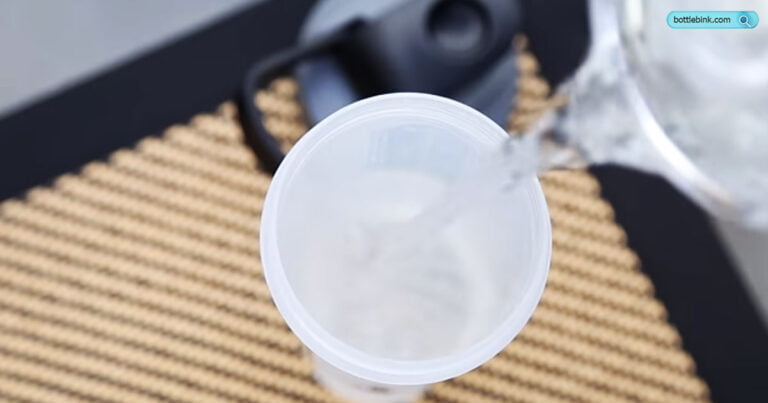Are Blender Bottles Microwave Safe? Discover Now!
Curious about Are Blender Bottles Microwave Safe? In this article, we’ll explore the topic and provide you with the information you need to use your Blender Bottle with confidence.
Blender bottles are a popular choice for fitness enthusiasts and people who are always on the go. They’re great for mixing up protein shakes, smoothies, and other drinks on the spot. However, are these blender bottles microwave safe?
This is the very common query that may peep into your mind. And the short answer is: it depends. Most blender bottles are made of plastic, and some plastics are not microwave safe. Additionally, the metal blender ball that is included in many blender bottles can also be a hazard when microwaving!
Let’s have a deep insight!
Why are some plastics not microwave safe?
When plastics are heated in the microwave, they can release harmful chemicals that may eventually enter into your food or drink. These chemicals can be cause of a variety of health problems, including cancer, reproductive disorders, and developmental delays.
Why is the metal blender ball a hazard?
Metal objects can create sparks in the microwave, which can ignite the contents of the bottle. Additionally, metal can heat up very quickly in the microwave, that may lead to burns.
Understanding Microwave Safety For Blender Bottles
Blender bottles are portable containers used for quickly mixing protein shakes, smoothies, and other powdered beverages. They typically have a secure lid and a built-in mixing mechanism, such as a wire whisk ball or a blending disk. Hence, the primary purpose of blender bottles is to provide convenience and ensure a smooth and consistent blend.
When it comes to using blender bottles in the microwave, it is important to consider microwave safety. Though many blender bottles are made from plastic materials that are microwave-safe, not all blender bottles are suitable for microwaving. Rather, microwaving certain types of plastic can cause them to melt, leach harmful chemicals, or release toxic fumes.
So, before microwaving a blender bottle, it is essential to check whether it is labeled as microwave-safe. If the bottle is made from BPA-free plastic and explicitly states that it is microwave-safe, it can generally be used in the microwave. However, it is always recommended to follow the manufacturer’s instructions to ensure safety.
Ignoring microwave safety precautions for blender bottles can leave potential risks. Microwaving non-microwave-safe bottles can lead to structural damage, including warping or melting. This damage may compromise the bottle’s integrity and potentially cause leaks or spills when using it in the future.
Moreover, microwaving certain plastics can release harmful chemicals into the contents of the bottle, which may have health implications when consumed.
On the whole, it is crucial to understand microwave safety when using blender bottles. Always check the label for microwave-safe indications, and follow the manufacturer’s instructions to avoid any potential risks or damage to both the bottle and your health!
Identifying Blender Bottles That Are Microwave Safe
When purchasing a blender bottle, it is important to ensure that it is microwave safe if you plan using it to heat up liquids or food items. To determine whether a blender bottle is safe to use in the microwave, there are a few steps you can take:
Reading product labels and specifications: Take a close look at the product labels and specifications provided by the manufacturer. Look for any indications or statements regarding microwave safety.
Looking for microwave-safe symbols or labels: Some blender bottles may have specific symbols or labels indicating that they are safe for using in the microwave. Look for symbols such as a microwave icon or labels that explicitly mention microwave safety.
Researching manufacturer recommendations: Visit the manufacturer’s website or contact their customer service to inquire about microwave safety. They may provide specific instructions or recommendations regarding microwave use.
By following these steps, you can choose a blender bottle that is safe to use in the microwave, allowing you to conveniently heat up your beverages or meals.
Factors To Consider Before Microwaving Blender Bottles
Blender bottles have been popular for mixing beverages and ensuring smooth and clump-free protein shakes. However, when it comes to microwaving blender bottles, certain factors need to be considered to ensure safety and prevent potential damage.
The material composition of blender bottles is a key determining factor in their microwave compatibility. Most blender bottles are made from high-quality plastics such as polypropylene (PP) or polyethylene (PE), which are generally considered microwave safe. These materials have a high heat resistance and are designed to withstand the microwave’s heating process.
Another important consideration is the blender bottle’s compatibility with microwaveable materials. It’s crucial to ensure that the lid, seal, and any other components are also microwave safe.
Some blender bottles come with removable parts that may not be suitable for microwave use. So, it is recommended to check the manufacturer’s guidelines or product labeling to confirm microwave compatibility.
| Material Composition | Compatibility with Microwaveable Materials | Maximum Temperature Limitations |
| Polypropylene (PP) | Yes | Generally up to 100°C (212°F) |
| Polyethylene (PE) | Yes | Generally up to 100°C (212°F) |
Maximum temperature tolerance are also important to consider when microwaving blender bottles. While most blender bottles can safely handle temperatures up to 100°C (212°F), it is crucial to ensure that the specific bottle you are using does not have lower temperature limitations. Exceeding these limitations can lead to warping, deformation, or even release of harmful chemicals.
In summary, before microwaving blender bottles, it is essential to consider the material composition, compatibility with microwaveable materials, and maximum temperature limitations. By following these guidelines, you can ensure the safety and longevity of your blender bottles.

Potential Risks Of Microwaving Non-microwave Safe Blender Bottles
Blender bottles are commonly used for mixing and drinking protein shakes and other supplements. However, it is important to know if these bottles are safe to use in a microwave. Microwaving non-microwave safe blender bottles can cause potential risks!
One of the risks associated with microwaving non-microwave safe blender bottles is the release of harmful chemicals. When these bottles are exposed to high temperatures, they may release chemicals that can contaminate the contents of the bottle. These chemicals can be hazardous to health if ingested.
Another risk of microwaving non-microwave safe blender bottles is the possibility of damaging the bottle itself and compromising its functionality. The heat from the microwave can cause the plastic to melt or warp, leading to leaks or breakage.
Using non-microwave safe blender bottles can also result in potential health risks. Heat can cause the plastic to degrade, releasing toxins into the contents of the bottle. Ingesting these toxins can have harmful effects on the body!
So, if the bottle is not labeled as microwave safe, it is best to avoid microwaving it altogether and consider alternative methods for warming or heating the contents.
Alternative Methods To Heat Blender Bottles
When it comes to using Blender Bottles in the microwave, caution is a must. Though many Blender Bottles are made from microwave-safe materials, it is important to check the specific instructions for your bottle before attempting to heat it in the microwave.
However, if you are looking for alternative methods to heat your Blender Bottle, here are a few options to consider:
| Method | Description |
| Hot water baths | Fill a larger container with hot water and place the closed Blender Bottle inside for a few minutes to heat the contents. |
| Heat-retaining accessories | Consider using insulated sleeves or covers to help retain heat and keep your liquids warm for longer periods. |
| Preheating liquids | If you want to enjoy a warm drink or a protein shake, try preheating the liquids before pouring them into the Blender Bottle. |
Can you put hot liquids in a blender bottle?
No, you should not put hot liquids in a Blender Bottle. That’s because blender Bottles are made of plastic, and hot liquids can damage the plastic and make it more likely to crack or break. Additionally, the heat from hot liquids can cause the pressure inside the bottle to increase, which may cause the lid to pop off or the bottle to burst.
If you need to heat a liquid that is in a Blender Bottle, it is best to transfer it to a microwave-safe container before doing so. You can also try using a hot water bath to heat the liquid in the Blender Bottle. To do this, simply fill a larger container with hot water and place the Blender Bottle inside.
Let the bottle sit in the hot water for a few minutes, or until the contents have reached the desired temperature.
Here are some additional safety tips for using Blender Bottles:
- Never microwave the Blender Bottle with the BlenderBall® whisk inside.
- Do not use the Blender Bottle to store hot or warm liquids.
- Be careful when mixing ingredients that may create pressure inside the bottle, such as pancake batter or waffle batter.
- Always point the spout away from your face when opening the flip cap.
- Wash the Blender Bottle immediately after each use.
- Inspect the Blender Bottle regularly for signs of wear and tear.
By following these tips, you can be sure that your Blender Bottle lasts for many years.
Tips For Using Blender Bottles Safely
Here are some tips for using Blender Bottles safely:
- Never microwave the Blender Bottle with the BlenderBall® whisk inside. The metal whisk can create sparks and cause a fire.
- Do not use the Blender Bottle to store hot or warm liquids. The heat can damage the plastic and make it more likely to crack or break.
- Be careful when mixing ingredients that may create pressure inside the bottle, such as pancake batter or waffle batter. If too much pressure builds up, the lid can pop off or the bottle could burst.
- Always point the spout away from your face when opening the flip cap. This will help to prevent any liquid from spraying into your eyes or mouth.
- Wash the Blender Bottle immediately after each use. This will help to prevent the growth of bacteria and mold.
- Inspect the Blender Bottle regularly for signs of wear and tear. If you notice any cracks, chips, or other damage, replace the bottle immediately.
Here are some additional tips for getting the most out of your Blender Bottle:
- Use cold liquids for best results. Cold liquids will help to create a smooth and frothy shake.
- Add the BlenderBall® whisk to the bottle before adding any ingredients. This will help to prevent the whisk from getting stuck in the bottom of the bottle.
- Shake the bottle vigorously for at least 30 seconds. This will ensure that all of the ingredients are well blended.
- If you are making a protein shake, add the protein powder to the liquid last. This will help to prevent the protein powder from clumping.
- Enjoy your delicious and nutritious shake!
By following these tips, you can make your Blender Bottle lasts long.
Dos And Don’ts For Microwave Blender Bottles
Dos:
- Do use a microwave-safe container to heat liquids that are in a Blender Bottle.
- Do use a hot water bath to heat the liquid in the Blender Bottle. To do this, simply fill a larger container with hot water and place the Blender Bottle inside. Let the bottle sit in the hot water for a few minutes, or until the contents have reached the desired temperature.
Don’ts:
- Don’t microwave the Blender Bottle with the BlenderBall® whisk inside.
- Don’t use the Blender Bottle to store hot or warm liquids.
- Don’t microwave the Blender Bottle if it is cracked, chipped, or damaged in any way.
FAQs Of Are Blender Bottles Microwave Safe
Are Blender Bottles Microwave Safe
No, Blender Bottles are not safe for the microwave. Using them in the microwave can cause them to break or become deformed. It’s safer to heat your liquids or ingredients in a microwave-safe container before transferring them to the Blender Bottle.
Can Protein Shakers Go In The Microwave?
No, protein shakers should not be microwaved as they are typically made of plastic which can melt or release harmful chemicals when exposed to high heat. So, it is best to transfer the contents to a microwave-safe container if you need to heat your protein shake.
How Do You Sterilize A Blenderbottle?
To sterilize a BlenderBottle, wash it with warm, soapy water. Rinse thoroughly, and then submerge the bottle in boiling water for 2-3 minutes. Alternatively, you can run it through the dishwasher on a hot cycle. Allow it to air dry completely before using again.
Do Blender Bottles Leach Chemicals?
Blender bottles do not leach chemicals. They are made of food-grade materials that are safe and free from harmful substances. Enjoy your smoothies worry-free!
How Long Do You Shake A Blenderbottle?
Shake a BlenderBottle for about 30 seconds to blend ingredients thoroughly.
Conclusion
To wrap up, Blender Bottles are not microwave safe. That’s because the combination of plastic material and metal shaker ball can cause the bottle to warp, crack, or even melt in the microwave. Hence, it is always crucial to follow the manufacturer’s instructions for safe usage.
So, rather than risking damaging your Blender Bottle or compromising your safety, it’s best to stick to using it for mixing and transporting drinks.






